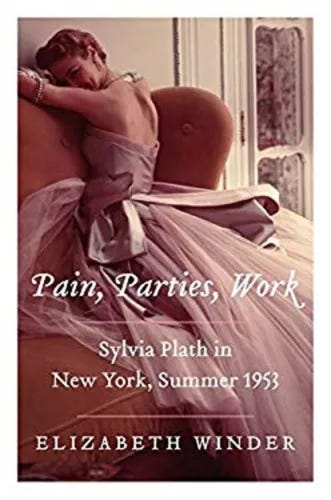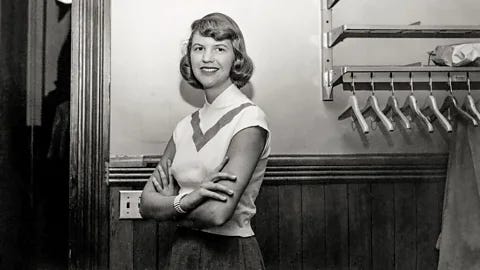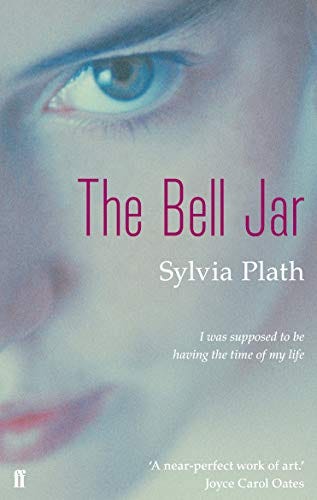Welcome to A Narrative of Their Own, where I discuss the work of 20th century women writers and their relevance to contemporary culture.
If you enjoy reading essays on literature as well as monthly reviews of great books and recommended reading, please consider a free or paid subscription.
Following a recent visit to my university library for research, I got waylaid at the Sylvia Plath shelves. This often happens; there are at least three long shelves fully stacked with biographies and critical studies of Plath, who remains such a mythic writer to many people (including me).
Anyway, a specific book caught my eye which I hadn’t seen before, Elizabeth Winder’s Pain, Parties, Work: Sylvia Plath in New York, Summer 1953. This one really stood out because, unlike the many discussions on her death, her poetry, and her marriage to fellow-poet Ted Hughes, Winder has delved into Plath’s time at Mademoiselle magazine in New York where she and nineteen other college girls, who had all won a one month editorship at the magazine, lived for one month together at the Barbizon hotel. I thought it would be interesting to discover more about this time in Plath’s life; before Cambridge and Ted, the phenomenal poetry collection Ariel and her suicide just ten years later at the age of thirty.
In her author’s note at the start of the book, Winder is keen to point out that Plath was a participant and product of mid-century America. Often seen as a mythical, tragic genius, at this time in her life, Plath loved fashion, clothes, shoes, parties, lectures, dances; went on lots of dates, and of course, always wore her trademark red lipstick. She was fully immersed in the material culture of the early fifties, and although we often think of her as a vulnerable young woman, Winder asserts that her troubles and thoughts at this time were not unlike the other young women of her generation.
‘[The difficulties she] endured were not unique, but part of a larger crisis - being an ambitious, curious girl in the 1950’s’.1
Plath had been dreaming of going to New York and she wanted to get every experience out of it that she could. She spent dedicated weeks planning her wardrobe for the trip beforehand, budgeting and saving, and going shopping specifically for the right clothes to take with her. Winder suggests that at twenty, far from being a tortured poet, Plath was much more likely to see herself in the same league as her peers.
“I dreamed of New York, I am going there.” Sylvia Plath, 15th May 1953, The Unabridged Journals.2
Winder shows a ‘euphoric’ Plath in the weeks leading up to the trip, seeing New York as an experiment to test her theories around work and the lifestyle she wanted for her future. The city became her infatuation.
Despite her carefully laid plans however, on her first morning on the job, Sylvia got a nosebleed and ruined her meticulously planned outfit. Changing for a replacement, this bothered her; the perfectionist tendencies that would be evident throughout her life were already in place. However, she arrived from Wellesley on 1st June 1953, accompanied by some young soldiers with whom she had made acquaintance on the train.
Sylvia had arrived in New York.
Each year, Mademoiselle selected twenty young college girls from around the country to work on a special ‘College Issue’ of the magazine. Whilst they were there to work and to learn, it was understood that there was a lot of chance to also have fun. Parties, dances, attending fashion shows and plays, dinners in fancy restaurants. As well as the plethora of famous writers who passed through the doors of the magazine; all of this awaited the young women.
In the book, Winder uses interviews with some of the other girls who were also awarded the month-long editorships at Mademoiselle, and appears keen to undo the cliched view of Sylvia as the ‘demon-plagued artist’.
She also gives great descriptions of the managing editor, Betsy Talbot Blackwell, known by all as ‘BTB’, as well as Cyrilly Abels, who Sylvia was allocated to work with as guest managing editor. Each girl was assigned a different editor to assist, however, as some of the women pointed out in interviews, they felt that Sylvia had it harder than the rest.
Cyrilly was a hard taskmaster and Sylvia, who always wanted to perform well, spent long hours at her desk, sometimes working well into the evening, while the other girls were having fun at parties and fashion shows. Some suggested that Sylvia should have been given the fiction editorship; in fact, she had hoped to meet and interview her hero, Dylan Thomas. Whilst working at the magazine, another young woman who did get the fiction editorship interviewed the writer, as well as meeting Tennessee Williams and Truman Capote. This was a great disappointment to Sylvia, although she did get to meet and interview the writer Elizabeth Bowen.
They also felt she would have thrived as the fashion editor, however, she was seen as the ‘writer’ of the group, and so was put to work by Cyrilly, who saw fashion as the frivolous side of the magazine.
Something that stood out to me was the handwriting analysis the women were given during their time at the magazine.
Unknown to them, a short piece of handwriting they had been required to submit at the start of their editorship was analysed by Herry O Teltscher, a professional analyst, looking for strengths and weaknesses. This was then presented to the women in writing.
Sylvia’s weaknesses included ‘stilted behaviour’ and ‘rigidity of outlook’, but Winder suggests she would have been overall pleased with the suggestion that her sense of form, beauty and style were ‘useful in fields of fashion and interior decoration’. She was also seen to be ‘eager for accomplishment’.
Winder suggests that Sylvia saw this as a green light: although she had always been a good student and wished to be a writer, she wasn’t as successful in the visual arts, and so she saw the result of her handwriting analysis as proof that she may be able to make it in the fashion magazine world.
However, as some of the others claimed they had been aware, Teltscher had written separately to Betsy Talbot Blackwell, warning her that one of her guest editors was on the brink of a nervous breakdown. It appears from the interview notes gathered that they knew it was Sylvia, with one even confessing that she felt Mademoiselle had contributed to Sylvia’s later breakdown.
They put this down to how hard Sylvia had worked during her month at the magazine as well as denying her the fiction editorship. Some also remarked on her coolness around others, seeing her behaviour as performative. An employee of the magazine commented that on meeting Sylvia before the editorship, she had worried that she might not be the right ‘fit’.
Sylvia herself had apparently found her role as guest managing editor demeaning, and it was agreed that she wasn’t well suited to editorial work. She had been expecting more dazzle and glamour from the role, not spending long hours at a desk, estranged from the other girls who were off having fun. It seems that Cyrilly Abels saw something promising in the young Sylvia, wanting her young protege to be like herself, seeing fashion and partying as frivolous sides to the magazine. She thought Sylvia, like herself, was too ambitious and intellectual to be interested in such things.
But Sylvia did manage to have fun in New York when she got the chance. She loved to drink and stay up late, going to the ballet, dancing and flirting. She enjoyed drinking alcohol and nursed hangovers with some relish. Although she had a boyfriend back home, she still enjoyed seeing other boys, though it was reported that she had been insanely jealous at the thought of her boyfriends being out with other girls.
As the month wore on and after a particularly long evening out in New York, followed by a lone walk back through the dark streets to the Barbizon, and with a 9am interview to conduct, Sylvia was becoming frazzled. She was caught crying that day at her desk because she had to work late, and to make matters worse, she was meant to be returning to Wellesley for her younger brother Warren’s graduation.
There was also the matter of the heat that June. As the temperatures intensified, the women were still expected to wear smart clothes, nylons and white gloves, and to be paraded around for photo shoots by photographer Herman Landshoff, who was ushering in a new style of urban femininity against the backdrop of the city. Sylvia also suffered from a bad bout of food poisoning after a meal out, as did most of her fellow editors, which left her further depleted.
Sylvia was beginning to unravel.
Winder points out however that Sylvia wasn’t alone in her exhaustion that month: the others had also begun to feel dragged down by the unaccustomed work, the partying, the late nights, and the gruelling heat of the city in summertime. They were also unused to having to be camera-ready at all times, posing for snapshots of the wonderful time they were having.
But Sylvia appears to have been particularly sensitive to the atmosphere around her. As one of her fellow editors pointed out, she was completely obsessed with the conviction of the Rosenbergs and their forthcoming execution. As anyone who has read The Bell Jar will know, the opening line refers to this moment in history, as Sylvia put it into the mouth of the protagonist, Esther Greenwood, when she, too, comes to New York for a special guest editorship at a fashion magazine.
“It was a queer, sultry summer, the summer they electrocuted the Rosenbergs, and I didn’t know what I was doing in New York.”3
The newspapers were full of the horror of the Rosenbergs sentence, but the other young women were either disinterested in the news, or else felt that the sentence was justified. One recalled finding Sylvia in the diner, anxious and covered in hives on the day set for their execution. She says Sylvia saw the Rosenberg’s as Jews, which she related back to her parents. Her mother Aurelia was the daughter of Austrian immigrants and had suffered name-calling as a child. Her father, Otto, was a pacifist, and Sylvia had grown up politically moved. It seemed that Sylvia became obsessed by the plight of the Rosenbergs and couldn’t accept the apathy of the other girls.
The other thing occupying Sylvia at this time, which formed the premise of many of Esther Greenwood’s concerns in The Bell Jar, was the fear of getting pregnant. This, again, was common amongst the other young women of her generation, and some of those interviewed refer to the sexual inequality and gender discrimination of the time.
Although she enjoyed flirting and going out on dates with boys, Sylvia was not someone who wanted to rush into sexual relationships. This wasn’t, as Winder points out, due to her religious or moral beliefs; she was just terrified of what would happen to her if she fell pregnant. She saw the only options of having an illegal abortion or ending up getting married, meaning a loss of autonomy and control, as unthinkable.
Her fear of marriage appeared to stem from her parents’ relationship. Otto Plath was an autocratic husband who had dominated Aurelia. In order to maintain a peaceful home, Aurelia had capitulated, leaving Sylvia to refer to her mother as a ‘martyr’ to her friends. Sylvia’s own literary ambitions did not fit with the example she had seen growing up, reporting to friends that her mother had foregone her own dreams of becoming a writer, first to her own father, then to her husband, and finally, to her children.
Mademoiselle magazine itself, meanwhile, appears to have given out mixed messages to its readers. Whilst it promoted careers for young women, it juxtaposed these features with advertisements for china sets and engagement rings. As Winder astutely points out, Sylvia appeared to be a woman just itching for the arrival of the 1960s.
What I found interesting (and a little disheartening) was that the other young women in later interviews have claimed that they, too, were struggling during their month in New York, but that none of them would have spoken of this to the others. Reminiscent of today’s ‘highlight reel’ on social media, their bright smiles and fashionable clothes hid the disappointment and loneliness many of them felt. They all assumed that the others were having a much better time than themselves.
On the final night of their time at the Barbizon, the women gathered in one room for a celebration. It ended late, whereupon Sylvia and a friend went up onto the roof of the building. There, Sylvia flung every item of clothing she had brought to New York with her off the roof of the hotel. Down floated silk slips, stockings and skirts to the pavement below.
As the champagne wore off however she realised she had nothing to wear on the train ride home. She had to borrow an outfit from one of the other girls who was packing her case, exchanging it for her bathrobe. Sylvia chose the most dowdy dirndl skirt and peasant blouse, almost as though she wished to distance herself from the glamour of New York.
It was a far cry from the nylons and sheath dresses she had arrived with; her adventure was over. Sylvia was ready for home and a summer filled with sunbathing and reading.
Always a lover of mermaids and the ocean since childhood, Sylvia returned home with a pair of plastic sunglasses in the shape of two starfish. They were a parting gift from the magazine, and the only thing she didn’t throw from the roof on her last evening in New York. She later noted in her journals that she brought them on her honeymoon.
The rest of Sylvia’s story is well documented, not least in her one and only published semi-autobiographical novel.
Returning to Wellesley, shrunken and depleted and without fanfare, Sylvia planned to spend the summer reading James Joyce’s Ulysses. But she found the words in the books, always such an easy thing for her, just wouldn’t sit still. Worse, the ambitious straight A student was rejected by a summer fiction writing class she had her heart set on. She had lost confidence in her reading and writing abilities. She began to think she had become illiterate.
Her mother noticed the change in her and encouraged her, like any mother would, to relax, let go, and take some time to recover. Sylvia began to tell her mother of her fears that if she could no longer read and write, then what was she to do with her life? She even asked Aurelia to teach her shorthand in order to instil some much-needed routine, giving up after a few sessions, much to her mother’s relief.
It was just fifty-eight days after returning from New York that Sylvia made her first suicide attempt, later being discovered by her brother Warren in the crawl space under the Plath’s home.
Eight years later, Sylvia would return to the story of her sweltering summer in New York, fictionalising the experience in The Bell Jar, as well as the months that followed which she spent recovering from her breakdown at McLean Hospital. Her story would eventually become referred to as a female version of The Catcher in the Rye; a story of mid-century American youth and the pressures of being female. The worries that plagued her also plagued her protagonist, Esther Greenwood, as well as many women of her era, not least her fellow guest editors at Mademoiselle.
Her book, published initially in the UK and under the pseudonym of Victoria Lucas, has never been out of print since.
Welcome to a narrative of their Own, an essay newsletter discussing the lives and literature of women.
If you enjoy reading essays on literature as well as monthly reviews of great books and recommended reading, please consider a free or paid subscription.
Elizabeth Winder, Pain, Parties, Work: Sylvia Plath in New York, Summer, 1953 (Harper Collins: USA, 2013).
Sylvia Plath, The Unabridged Journals of Sylvia Plath, ed. Karen V Kukil, (Knopf Doubleday: USA, 1982).
Sylvia Plath, The Bell Jar, (Faber & Faber: London, 2005 [1963]).








Love this dive into Sylvia Plath, thank you! And check out Penny Zang's novel, _Doll Part_s (coming this summer) and Emily Van Duyne's _Loving Sylvia Plath_ for more Plath love. <3
Thanks, loved reading that